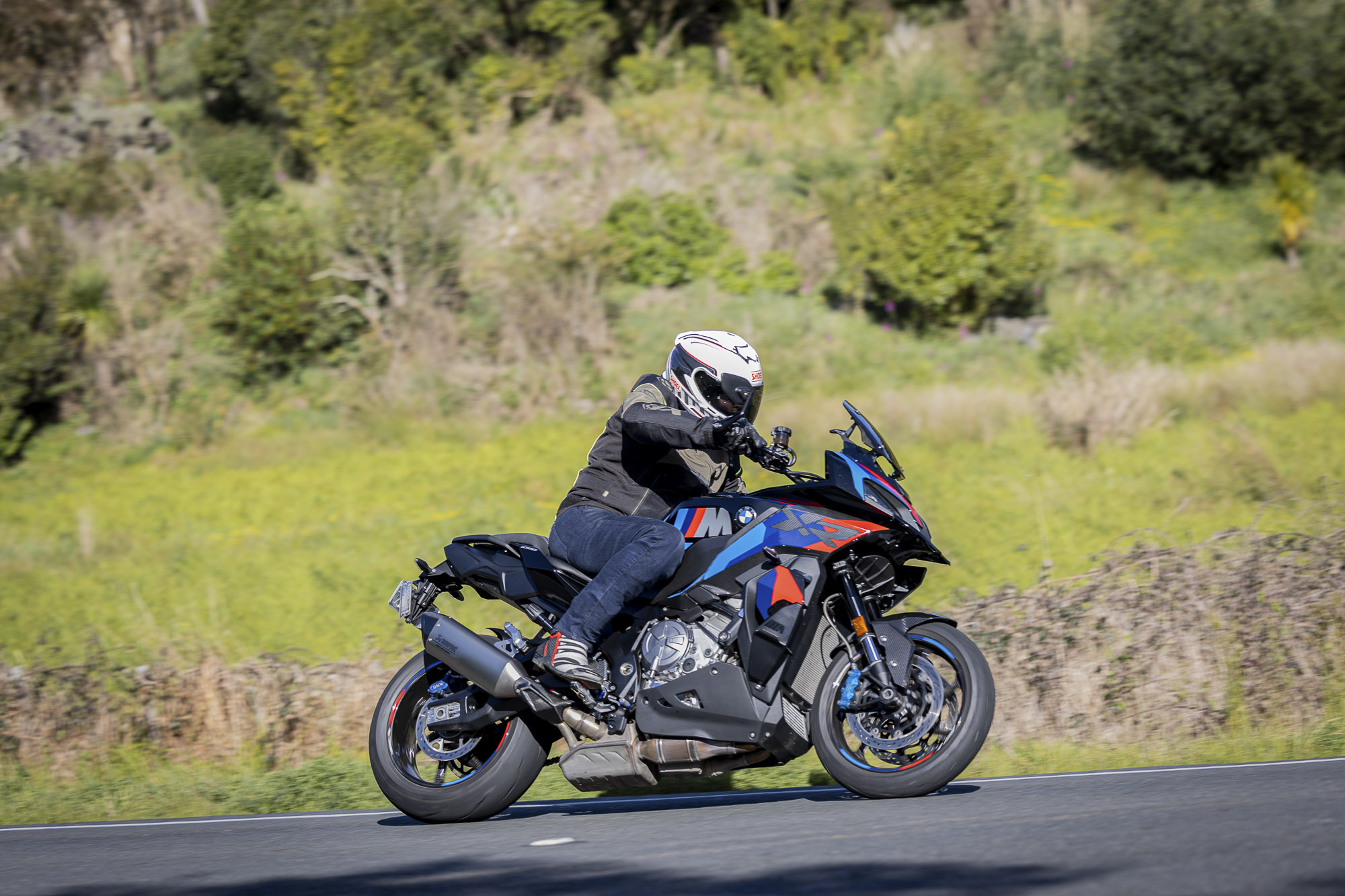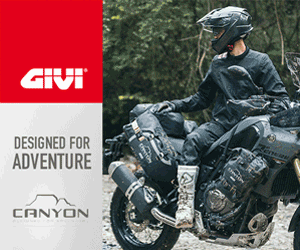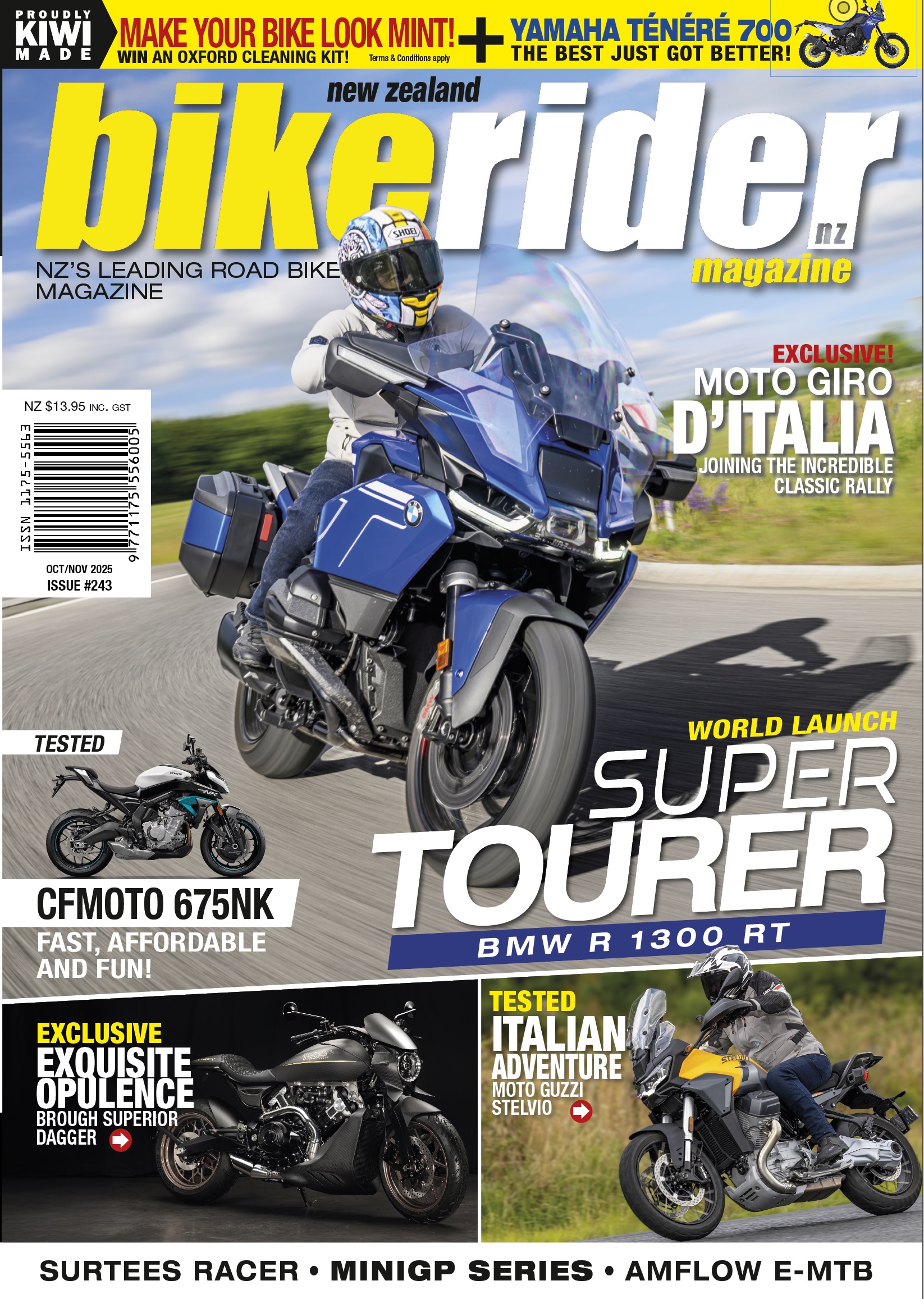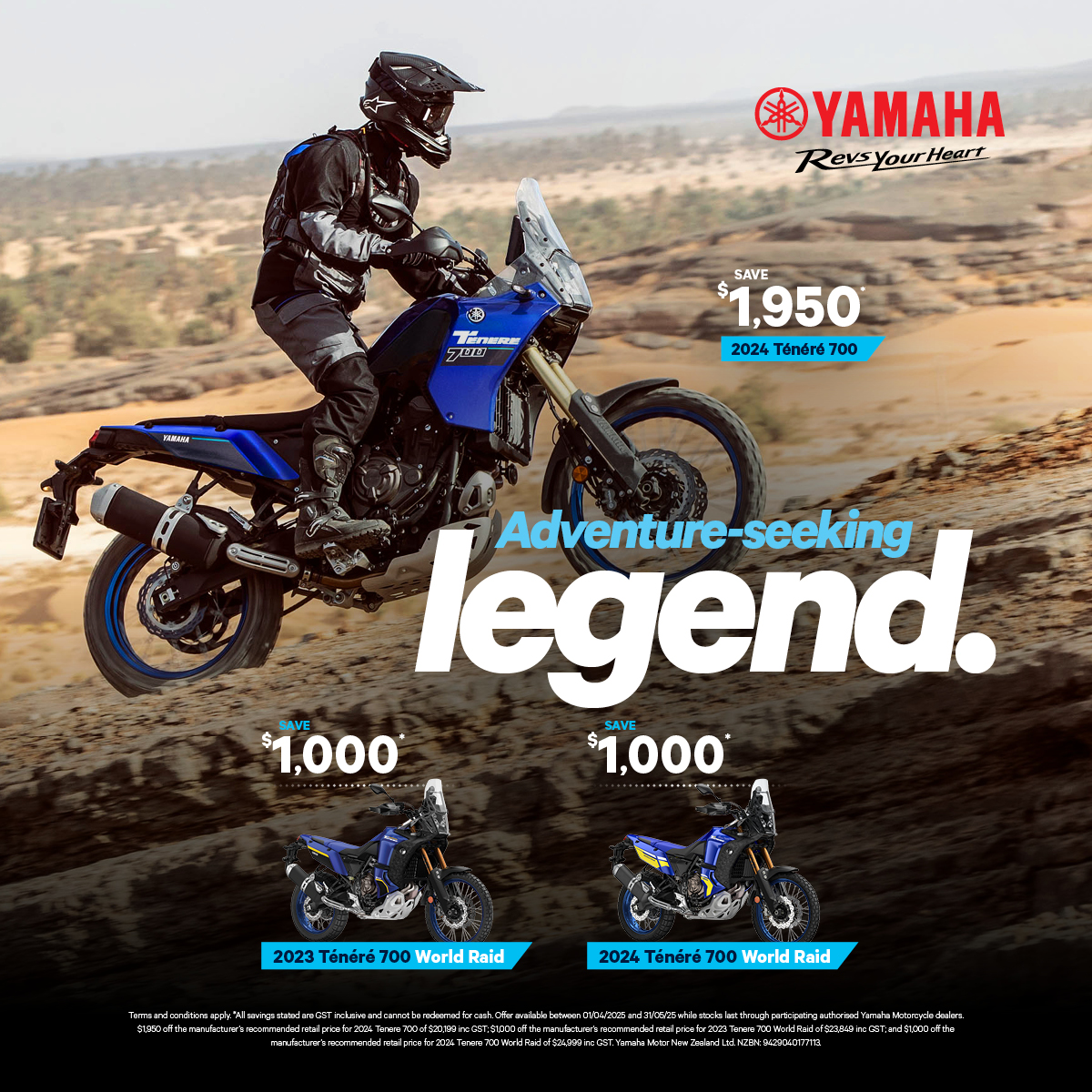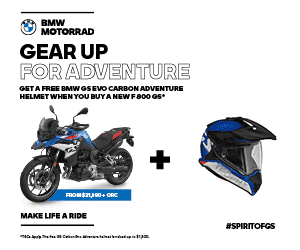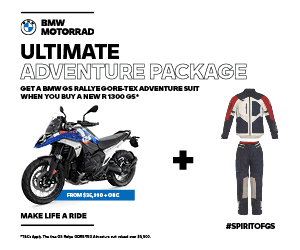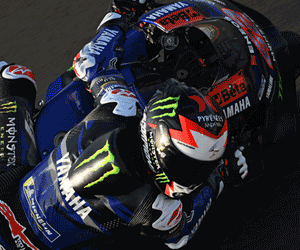- 201hp off the showroom floor is 27hp more than the already blisteringly quick S 1000 XR.
- M-Sport touches mean lots of carbon including lightweight wheels.
- Wings add 12kg of downforce at 200km/h.
Words: Paul Pics: Two Creative Photography
A bit of M-sport magic has turned BMW‘s in-line four crossover from an already rapid tourer into a devastatingly quick intercontinental ballistic missile that’s comfortable enough for two.
BMW’s new M 1000 XR is more than a motorcycle; it’s an engineering masterpiece that brings sportbike performance to the crossover touring category. The Bavarian marque has infused its top-tier “M” magic into the already stellar S 1000 XR, creating a machine that’s faster, sharper, and more capable than ever before. With a staggering 201hp, cutting-edge aerodynamics, and top-shelf components, the M 1000 XR redefines what a sports tourer can be, and is comfortable enough for touring around the country yet quick enough to embarrass lots of sporting machines down your favourite twisty road. Hell, this thing will even show a clean set of heels to plenty of machines on a racetrack! With a few M tweaks and the addition of the full-monty shift-cam RR motor, BMW has upped the ante with their crossover and produced a comfortable bike with all the performance of a superbike yet still supplying supreme comfort for those who don’t want to be crouched over in a sportsbike dance.
At the heart of the M 1000 XR is the brilliant inline-four engine from the game-changing S 1000 RR superbike, retuned to produce 201hp at 12,750rpm (down from 210hp @ 13,750rpm) and 113Nmof torque at 11,000rpm. Compared to the standard S 1000 XR, which already offers an impressive 174 hp, this is a quantum leap, with the extra power transforming the XR from a quick tourer into a bike capable of rivalling even the most dedicated superbikes in outright speed. And while it’s not anywhere near as pretty as the most popular superbikes, including BMW’s own (and slightly polarising S 1000 RR), the large M on the tank, lashings of carbon fibre (including the wheels) and dedicated colour scheme make this almost a two-wheeled version of BMW’s performance SUV. And I loved it!
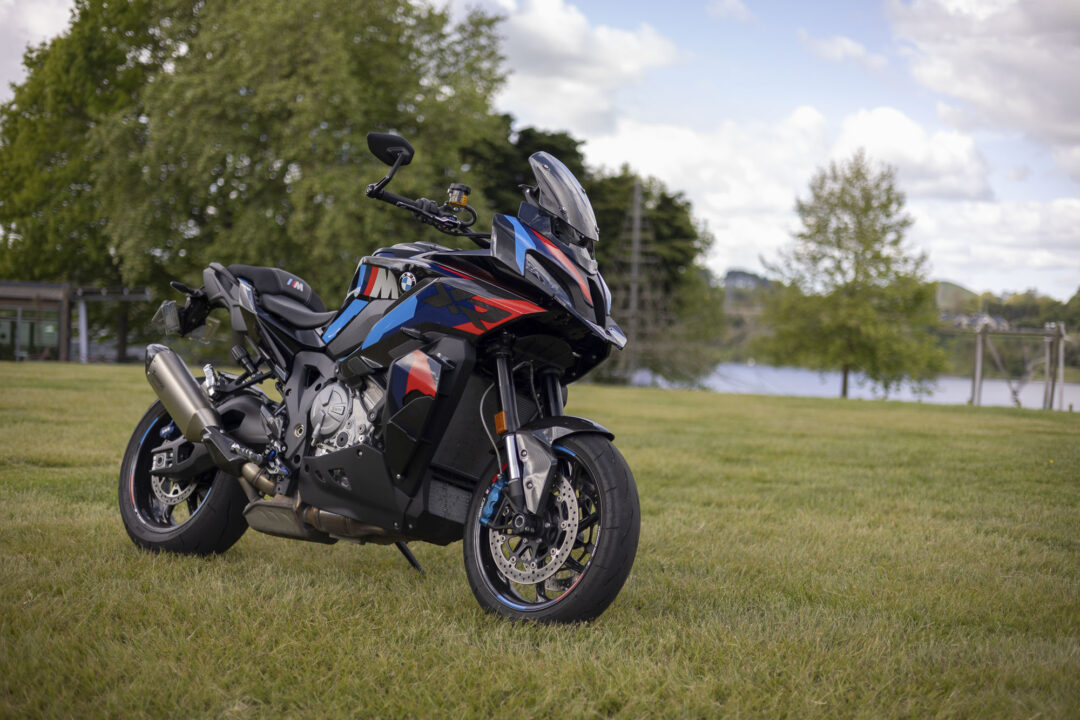
There’s no denying that the XR is a large bike, with the saddle sitting 850mm from the ground and giving me a decent stretch to the floor, although with a wet weight of 223kg, it doesn’t feel heavy. This particular model that we’ve got to test had the Competition Package option, which sees a whole host of goodies added to the base price of $47,990, making this expensive but also seriously sorted motorcycle. There are lashings of carbon fibre everywhere you look dropping 3kg; you get blue anodised bits with adjustable footpeg levers, hand leavers which are foldable, and BMW’s blue-anodised M calipers with a new master cylinder that provide phenomenal stopping power with excellent feel, even under heavy braking. Oh, and you get a big M down the side, so everybody knows this is something special.
There’s a beautiful Akrapovič exhaust as well that sounded surprisingly quiet when I started the XR up, but I discovered it provides a satisfying howl when you get the revs up and you’re making the most of some fantastic roads. But the best bit is the carbon wheels, which reduce the unsprung weight and make the XR handle with the same sort of speed as its sportier siblings. If you haven’t ridden with carbon wheels before, it really is a revelation, transforming the whole experience with this XR and making it feel incredibly light as you flick it from one side to the other.
From the cockpit, while there’s a nice ‘M’ graphic on the TFT dash at start-up, it’s pretty much the same as you’d get on the standard XR. But that’s not a bad thing as BMW’s TFT dash and the wheel to control it on the left switchblock is seriously easy to navigate, with an intuitive layout making it easy to control settings without the need to study a manual. The small ‘sport’ windscreen might not look like it would be much to deflect the wind, but a lever offers a one-handed adjustment to click it into a taller position, something that I was grateful for on my first ride. And talking of wind, the M 1000 XR gets a set of what every self-respecting sportbike requires nowadays, a set of wings protruding out of the side of the fairing. Reportedly offering 12kg of downforce at 200km/h an hour, I initially thought they were simply a gimmick. But after a few days getting to know the M-XR, I wasn’t so sure.
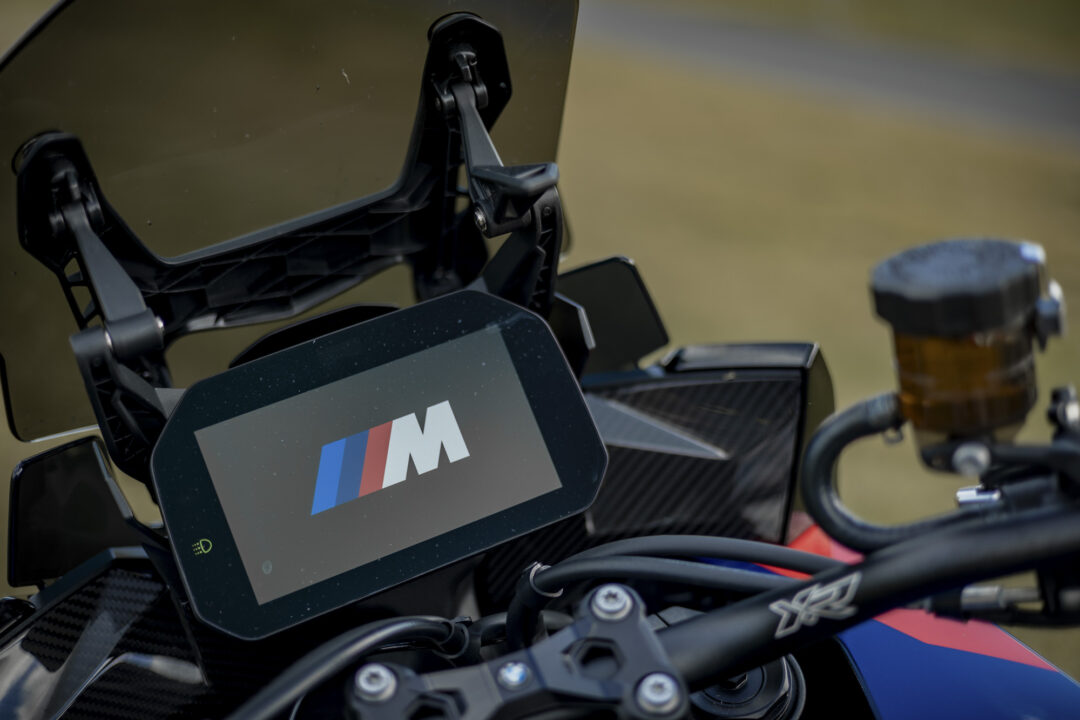
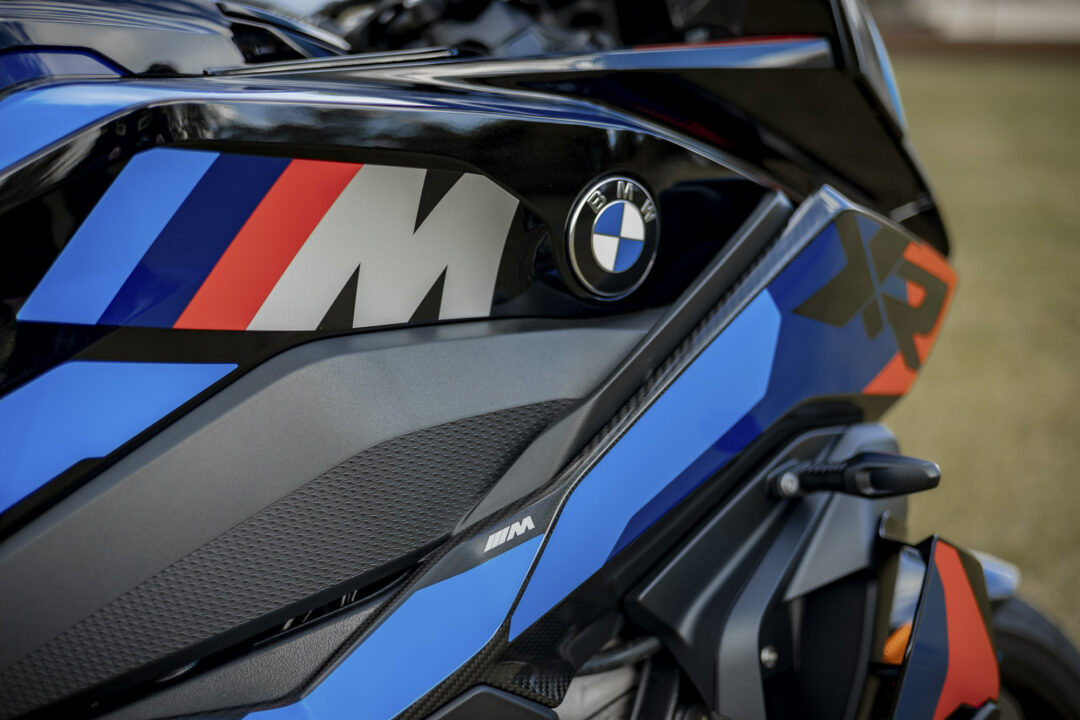
Easy Does It
Simply starting the XR lets you know this is a machine that you need to treat with respect. The engine note is angry as the four-cylinders begin the process of getting up to temperature when the electronic brain will then make the 201hp available to the rider – not before. It’s a smart system that limits revs until the engine is within the optimal operating temperature, which should ideally keep things running smoothly for longer, right?
Working through traffic and the bar-end mirrors make lane-splitting a bit more challenging than it needs to be, although I soon discover I can rotate them up so they are fractionally less wide, yet with the wings protruding from the fairing and my legs spread around the wide tank, the XR is a decent width.
Despite the rocketship performance available high around the rev-counter, subtle town work is easily performed thanks to steady fuelling and a beaut of a quickshifter, which essentially negates the use of the cable-operated clutch other than for starting and stopping. Oh, but what a sexy lever the clutch and brake have, with the folding item looking like it’s been made by a German engineering goddess. But this isn’t the environment where I want to be riding the M 1000 XR, and after negotiating a section of motorway using the cruise control after discovering rolling on the throttle in top-gear produced mind-bending levels of acceleration from 100km/h, I was definitely in need of somewhere quiet to put the M-XR through its paces. I did ask BMW if I could take it to the racetrack for a proper spanking (oops, sorry) testing… to which they replied it wouldn’t be insured, but they were happy for me to take the risk if I was happy to wear the consequences. Hmmmm, yeah/nah.
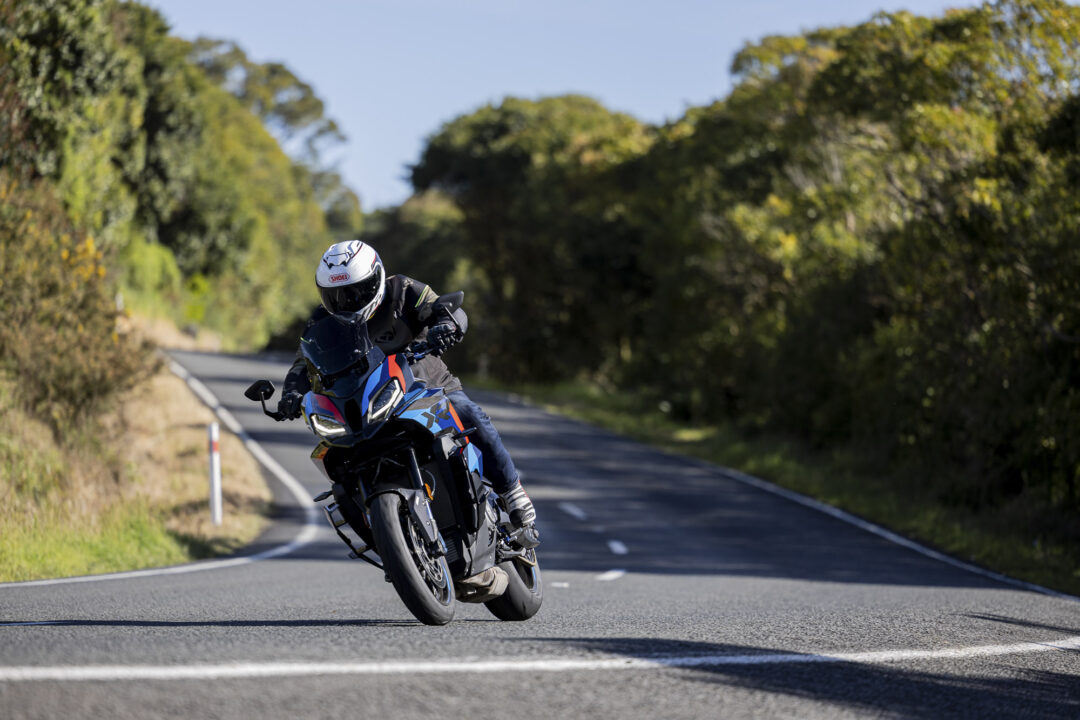
Getting out into the farthest reaches of my unofficial test route where I could up the pace and I was expecting the powerplant to be peaky, with 201hp up somewhere in the highest echelons of the rev counter. Oh, how wrong was I. Anything over 6,000rpm and the XR is pulling like a proverbial train, and for general, fast riding, all I needed to do was keep the revs between 6,000 and 8000rpm using the slick quickshifter and this is one seriously rapid bike. But hold onto the revs any longer than that, and the world starts going backwards, and things start to happen really quickly. Like, REALLY quicky!
Thankfully, the extra suspension travel and sit-up riding position of the XR makes all that horsepower usable on regular roads, even the crappy ones that we get here in New Zealand. The riding position is supremely comfortable, with a well-padded ‘M’ saddle and a decent pillion perch complete with a grab handle, so you should be able to persuade your better half to get on the back of this one. But you’ll have to be a little bit more reserved with your throttle hand, as unleashing all that horsepower with somebody on the back is likely to see them disappearing off behind you, never to be seen again.
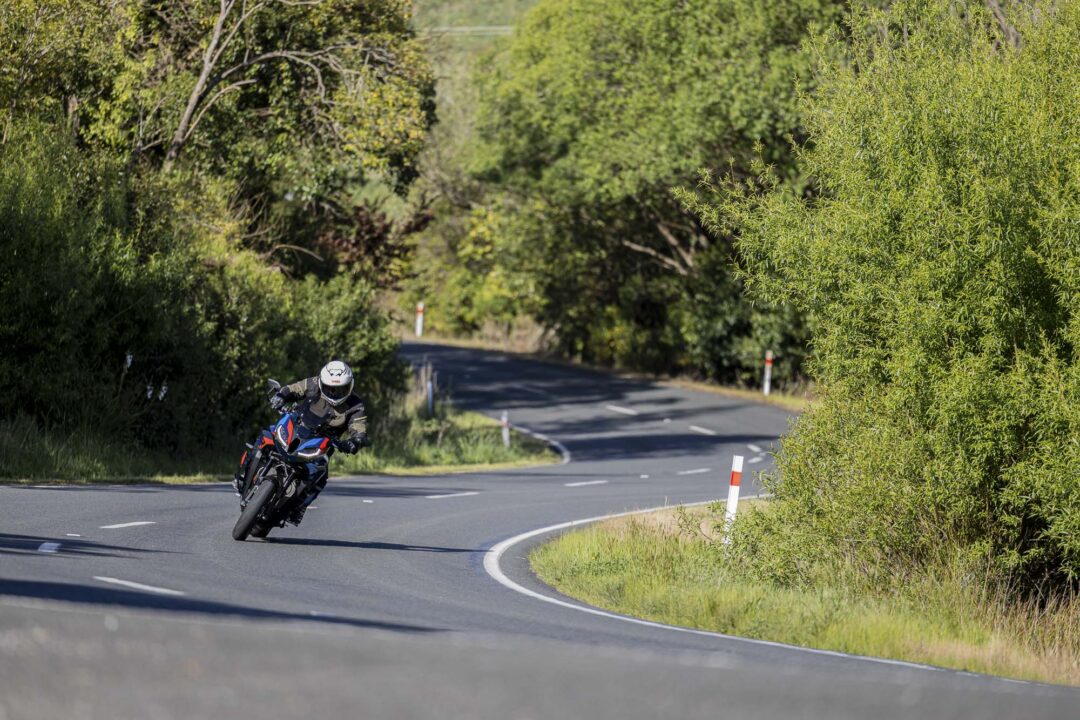
Like every other XR in the range, this is a sort of bike that you can click off a load of kilometres on in a day, especially with the super comfy saddle and the relatively relaxed riding position, with the XR-logoed handlebars swept back towards you quite a long way and a real sit-in riding position. The pegs are fully adjustable, so you can get a position set that’s just right for you, and the quickshifter means you don’t need to use your left hand much to flick up or down the gearbox. But when you get to some great roads on your trip, the M 1000 XR performs a magnificent trick of turning into a full-on sportsbike with a twist of your wrist, and there really isn’t much that’s gonna challenge you down a set of twisty roads, whether you’ve been on them before or not.
The performance from the BMW Shiftcam powerplant is just phenomenal, with drive seamlessly from almost tickover that just increases more and more the revs rise until, when it starts getting to the top of the rev-range, you really are looking for the next gear while also watching the horizon to make sure nothing pulls out or is approaching that might resemble anything close to a police car. And while an in-line four set-up is almost unusual nowadays in this style of bike, as we’re used to these sorts of machines featuring either a V twin or triple which have more power lower in the rev range, the BMW motor simply trumps them everywhere. Using Shiftcam technology (i.e. variable cam timing), BMW has managed to make this four-cylinder 1000cc powerplant super flexible, while also providing a blistering top-end that would shame many sportsbikes. The addition of the sit-up riding position and the long suspension travel make the M 1000 XR much more manageable down twisty and bumpy roads, and it’s never bucking or weaving as you’d normally find on something more focussed when you try to push on down country roads. Instead, the XR just soaks everything up, and you can concentrate on looking ahead, picking your line while making the most of that incredible performance that’s on tap.
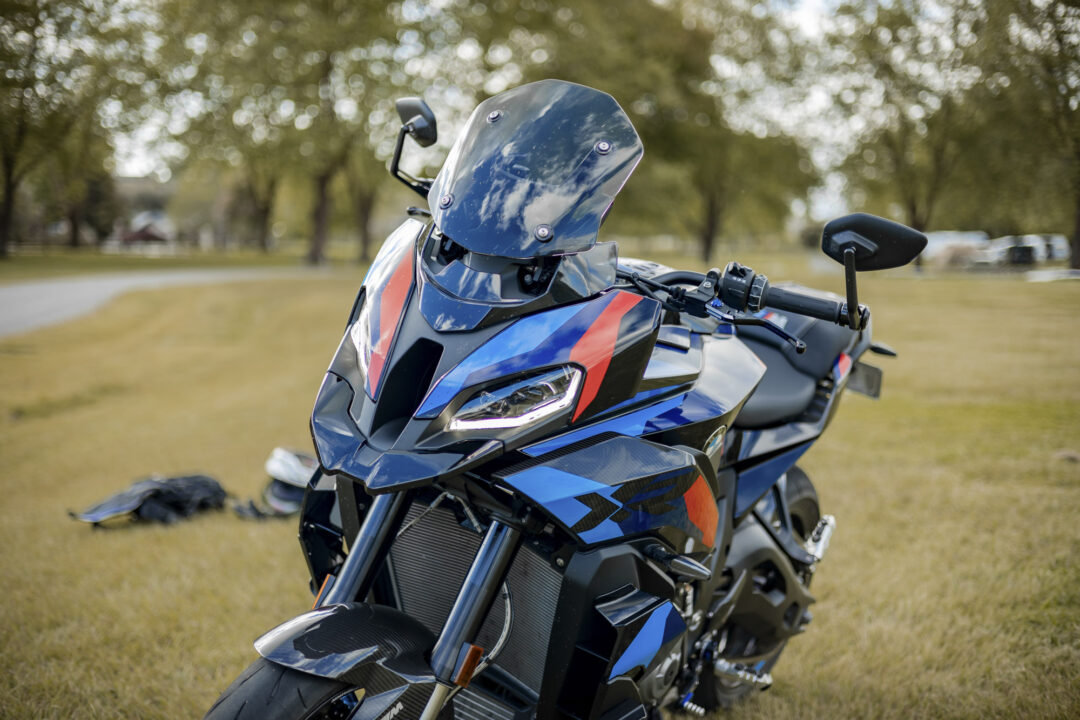
Not For Beginners
While trying to get as far away from civilisation while testing bikes, the M 1000 XR took the whole process to the next level, with a significant brain re-calibration required to cope with the ferocious speed achievable so easily by this machine. 0-100km/h takes only 3.2 seconds, while 200km/h is reached and passed 4.2 seconds later! So, this isn’t the sort of bike you want to go and get as a returning rider with a bit of cash to burn now the kids have left home. Yep, you might drive an M-series car, but this is a whole different game.
I usually try and keep my speeds below the point where an inopportune encounter with the local law enforcement would see a long walk home and a bike impounded for 30 days. And if that’s not possible, well, somewhere between there and going to jail is the next measure. Well, with the M 1000 XR all bets were off, with the cornering speed on offer thanks to the combination of light-weight carbon wheels, electronic suspension and, I reckon, those wings, meant I was already in dangerous territory before the road even opened up. And when it did, the ferocity with which the XR leapt forward as I got on the gas was simply astonishing.
With almost no chance of finding a smooth road, I soon discovered it didn’t really matter as the combination of the factors that made cornering so stable also made the XR unbelievably secure while pushing hard over the sort of lumps, bumps and crests that would usually see handlebars wagging and me rolling the throttle off. Instead, the XR just smoothed everything out, with that 12kg of downforce obviously keeping the machine planted while the electronic suspension soaked it all up underneath me. Add into the mix a combination of the latest electronic aids including wheelie control (seriously important), traction control (yep, really need it) and dynamic brake control (yeah, probably needed that too!) along with switchable mapping, and you can dial the XR to suit whatever type of riding you’re doing or mode you’re feeling. Chucking it into Rain mode dulls the throttle response and power output while upping the aids, although I spent most of my time in Road or Dynamic.
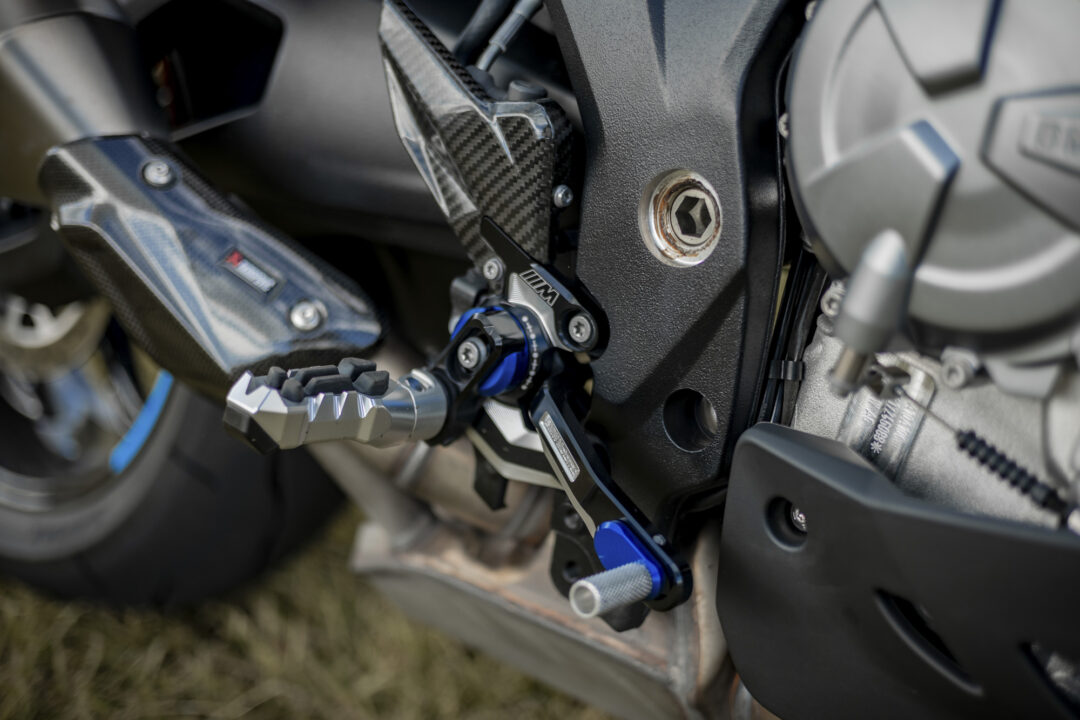
With Dynamic, the ‘brain’ ups the suspension response automatically with the type of riding it figures I’m doing at the time, so it’s the perfect option for a set-and-forget setting as the bike is working it out for you. I didn’t bother with Race or Race Pro. What did surprise me was the jump in performance between each mode. I thought the M-XR was fast when I was in Road mode, but swapping to Dynamic showed I’d only been scratching the surface as the Beemer added plenty more anger into the equation. Usually switching between modes makes a subtle difference in performance – not so with the M-XR.
With this sort of power combined with the ability to flick from one extremely lean angle to the other (the TFT dash has an option which displays live lean angle as well as G-force for and aft!), you need all the help you can get to scrub speed if required. And BMW hasn’t scrimped, with the anodised blue M-branded radial-mount calipers at the front supplied by Nissin, complete with braided hoses and a new master cylinder. Pull on that sexy billet brake lever, and you get eye-popping levels of power, although the switch with the master cylinder actually gives them heaps of feel, so they’re not overwhelming. And obviously, there’s all the usual BMW electronic wizard there to catch you if you really do get a little bit heavy-handed with a brake lever.
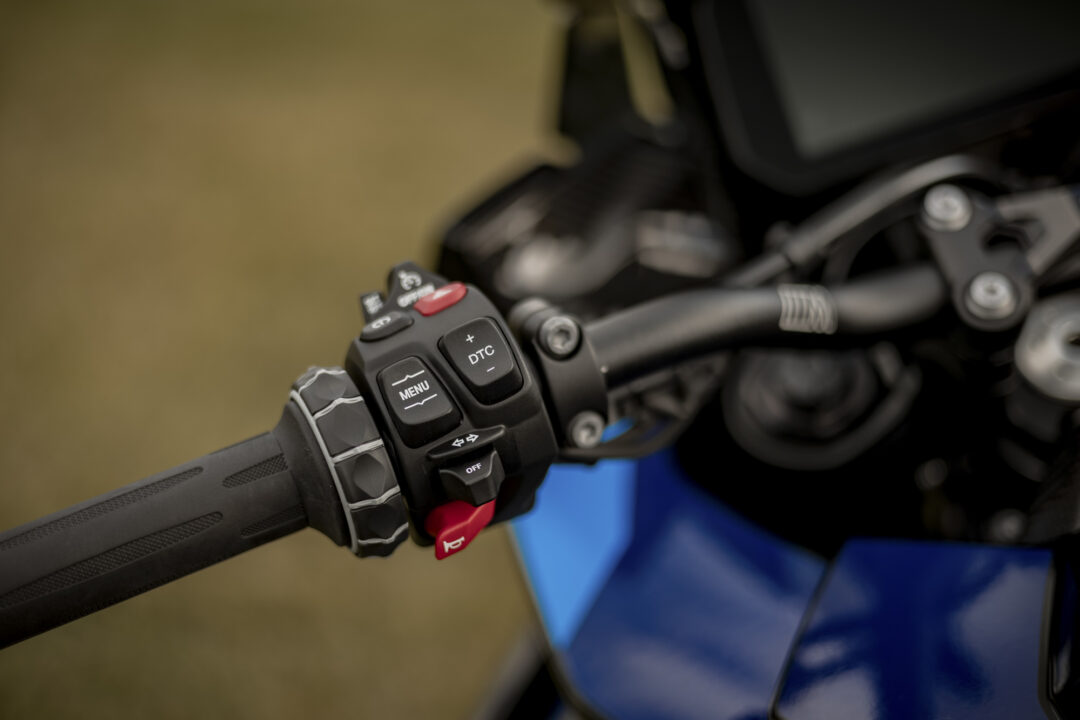
The electronic suspension adjustment is on the left-hand fork, while preload is done manually on the right-hand fork. There’s a steering dampener and a remote preload adjuster at the rear as well as full adjustability, while a serious set of Bridgestone‘s latest Battlax RS 11 Racing Street Tyres make sure there’s plenty of grip for, well, everything. I reckon you could go through tyres pretty fast on this, especially the rear! And you’ll never need to worry about ground clearance, with plenty available on this bike thanks to the crossover style.
While the M 1000 XR looks like an adventure crossover machine, this is one seriously sporty piece of kit, although somehow, BMW and the engineers have made it just as easy to tickle through traffic at 20km/h as it is for demolishing a set of twists and turns at 200. The front end isn’t particularly attractive, as is usually the case with this style of motorbike, although the traditional black/blue/red colour scheme of the M really does set it off. The LED headlights are dynamic, which means they look around corners, and the bar-end mirrors, while great for being able to see past your elbows, vibrate quite badly when you’re moving. So when you’re on the motorway, you can’t really see much of what’s going on behind you, which is quite important on a bike that encourages you to go as fast as this one does.
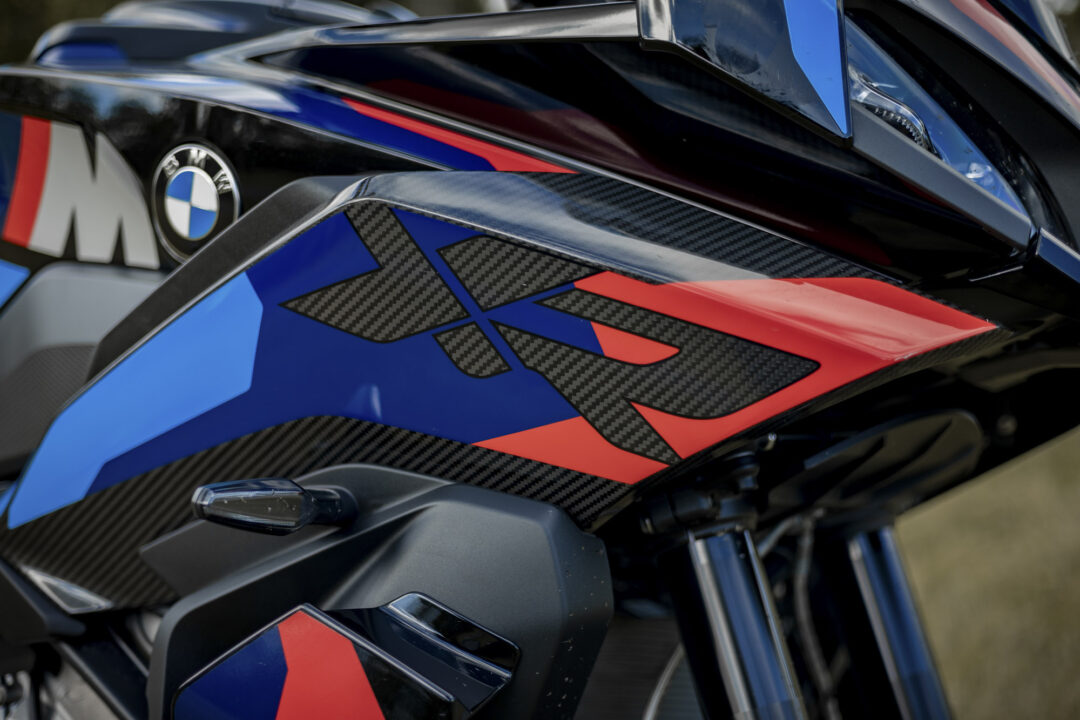
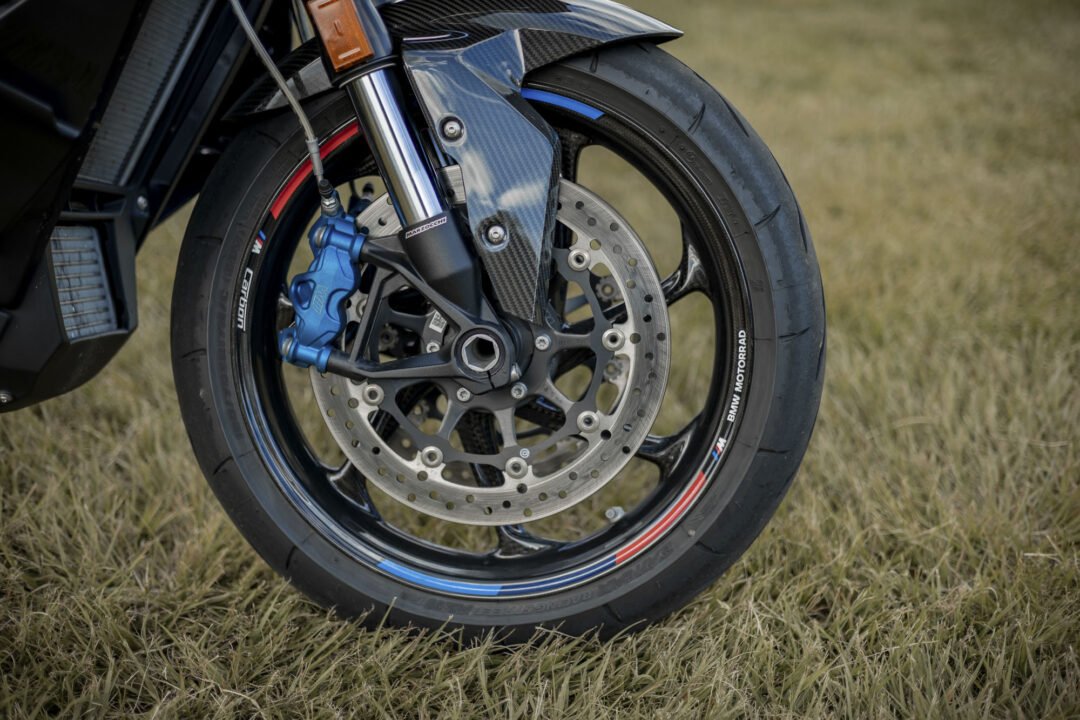
Conclusion
The BMW M 1000 XR is a remarkable machine that bridges the gap between superbike and sport-tourer like no other. With its explosive power, razor-sharp handling, and comfortable ergonomics, it’s a bike that can do it all.
At $57,000 with the Competition Package, it’s certainly a premium option. But for those who want the ultimate in versatility and performance, the M 1000 XR is worth every cent. Whether you’re carving through twisty back roads, cruising at high speeds, or simply enjoying the engineering marvel that it is, the M 1000 XR delivers an unforgettable experience.
BMW has set a new benchmark in the crossover segment, proving once again that when it comes to motorcycles, the M badge is synonymous with performance excellence.
Specifications
BMW M 1000 XR
Price
From $47,990
Type
999 cc, oil/water-cooled, four-cylinder, four-stroke, in-line engine with four valves per cylinder
Bore x stroke
80 mm x 49.7 mm
Compression ratio
13.3 : 1
Max power
148kW (201hp) at 12,750rpm
Max torque
113Nm at 11,000rpm
Gearbox
Claw-shifted 6-speed gearbox integrated in the transmission housing
Drive
Chain 525 17/47
CHASSIS
Frame
Bridge-type frame, cast aluminium, co-supporting engine
Front suspension
Upside-down telescopic fork, diameter 45mm, electronic self-adjusting rebound/compression damping (Dynamic ESA), 138mm travel
Rear suspension
Aluminium twin-sided swingarm, DDC Dynamic Damping Control (central shock absorber), adjustable spring preload, rebound and compression stages electronically adjustable, 138mm travel
Brake, front
Twin disc brake, diameter 320 mm, 4-piston fixed caliper
Brake, rear
Single disc brake, diameter 220 mm, 1-piston floating caliper
ABS
BMW Motorrad Integral ABS (partial integral, can be switched off)
ABS Pro
BMW Motorrad ABS Pro (settings for Rain, Road, Dynamic, Race mode)
Tyre, front
120/70 ZR17
Tyre, rear
200/55 ZR17
DIMENSIONS & WEIGHT
Height
1,382mm (above mirror, at DIN unladen weight)
Width
850mm (without accessories)
Wheelbase
1,548mm
Seat height at unladen weight
850mm
Length
2,170mm (over rear wheel)
Usable tank volume
approx. 20 l
Reserve
approx. 4 l
Unladen weight, road ready, fully fuelled
223kg
Performance / fuel consumption
Maximum speed
over 275 km/h
Fuel consumption per 100 km based on WMTC
6.5 l
Check It
www.bmw-motorrad.co.nz

